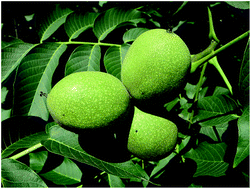Walnut (Juglans regia L.) shell pyroligneous acid: chemical constituents and functional applications
Abstract
Upon the processing of different agricultural products, considerable amounts of by-products and bio-wastes are produced and discarded or burnt as fuel, which are a potential source of valuable compounds. Over the past several decades, plant by-products have been recognized as a source of nutraceutical components, including dietary fibers, phenolics, and many other useful compounds. The walnut is known as an important tree nut. The shell of a walnut is the middle part of the fruit and it is a waste product of walnut processing industries. Recently, pyroligneous acids from the walnut shell have been receiving much-increasing interest because of their excellent antimicrobial and antioxidant activities. Hence, this review deals with the recent scientific literature on walnut shell pyroligneous acids and their chemical composition as well as their functional applications.



 Please wait while we load your content...
Please wait while we load your content...